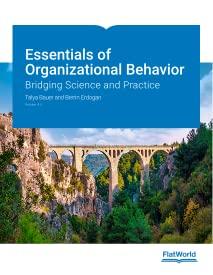The San Francisco-based Customer Relationship Management (CRM) company Salesforce.com is unique in many ways. The founder and
Question:
The San Francisco-based Customer Relationship Management (CRM) company Salesforce.com is unique in many ways. The founder and CEO, Marc Benioff, is known for his vision for philanthropy, which has been encoded into the 1-1-1 system embraced by the company. Specifically, Salesforce pledges to give back 1% of its equity, products, and employee hours back to communities in which they operate. Given the visionary leadership focusing on social issues, perhaps it is not surprising that diversity is one of the four core values of Salesforce. Except that instead of diversity, the company uses the term "equality." The company breaks with the tradition of appointing a Chief Diversity Officer, opting for a "Chief Equality Officer." This is a deliberate choice on the part of the company. The company's Chief Equality Officer, Tony Prophet, explains why diversity by itself is not enough:
"Diversity is absolutely essential, and we have work to do that, but once you have diversity you're not done. Then you have inclusion where you're really getting the very best out of every employee. When you have an inclusive environment, you feel seen, you feel included, and you feel valued.
You feel like you can bring your whole self to work. That is a competitive advantage to have a larger pool of talent. When you get ideas from people with different perspectives, the result is the beauty and the melding of their ideas, which adds to the complexity of the mosaic."
The company strives to cultivate a culture of Ohana (the word for "family" in Hawaiian language). It views inclusion as an ongoing goal to be strived for, and it deploys numerous tools and resources to achieve this goal. For example, the company currently has 12 Employee Resource Groups called Ohanas. These groups include Abilityforce (aiming to achieve an inclusive culture for people of all abilities and disabilities), Outforce (promoting an open and inclusive culture for employees of all sexual orientations and gender identities), and Faithforce (bringing together employees of all faiths). The goal of these groups is to ensure that employees can bring their whole, authentic selves to work. Half of the employees participate in at least one of these groups, with the goal that all senior executives are connected to one as an ally.
A key tool the company uses to ensure equality is to collect and use data to assess the status quo, identify areas for improvement, and take action. In 2015, the company made the news and spent $3 million to rectify their discovered gender pay gap. After their analysis revealed pay differences that could not be explained by geography, seniority, and responsibilities, they made adjustments to the pay of 17,000 employees (men and women), representing 6% of the company's workforce. They have since done an equal pay assessment every year. As of 2020, the company had spent over $12 million in addressing pay differences. The company publishes diversity numbers annually and measures the level of inclusiveness through questions in their attitude surveys.
The company supports numerous programs as part of its inclusive culture. A high-potential leadership program aims to provide leadership skills in order to help the advancement of women in the workplace. Coding workshops for girls seek to demystify programming for girls around the world. The annual equality award announced in their annual developer conference aims to raise the profile of diversity and inclusiveness trailblazers from all industries. The company views equality both as a key social issue to help create a better world, and a source of competitive advantage for their own success.
Questions
1. Why do you think Salesforce is committed to equality as a core value?
2. What are your thoughts regarding the distinction between diversity and inclusion (or equality, as it is called in the case)? Do you believe diversity without inclusion can be effective? Or inclusion without diversity?
3. Salesforce clearly puts a lot of resources into ensuring inclusiveness. Which of the methods described in the case are applicable to a smaller business with more limited resources? Do you believe that effective management of diversity necessitates a resource-rich environment?
4. The company had to rectify a gender pay gap twice. What would be your advice for companies aiming to achieve pay fairness? What are ways in which companies may structure their pay systems so that gender pay gap does not emerge in the first place?
5. What is the value of employee resource groups? Under which conditions do you believe such programs will be effective tools in helping to develop an inclusive culture?
Step by Step Answer:

Essentials Of Organizational Behavior Bridging Science And Practice
ISBN: 9781453339244
1st Edition
Authors: Talya Bauer, Berrin Erdogan





